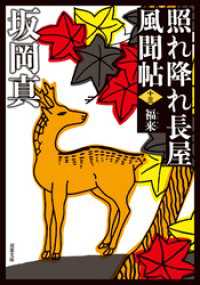Full Description
This innovative book reassesses the history of musicology, unearthing the field's twentieth-century German and global roots. In the process, Anna Maria Busse Berger exposes previously unseen historical relationships such as those between the modern rediscovery of medieval music, the rise of communal singing, and the ways in which African music intersected with missionary work in the German colonial period. Ultimately, Busse Berger offers a monumental new account of the early twentieth-century music culture in Germany and East Africa.
The book unfolds in three parts. Busse Berger starts with the origins of comparative musicology circa 1900, when early proponents used ideas from comparative linguistics to test whether parallels could be drawn between nonwestern and medieval European music. She then turns to youth movements of the era—the Wandervogel, Jugendmusikbewegung, and Singbewegung—whose focus on joint music making influenced many musicologists. Finally, she considers case studies of Protestant and Catholic mission societies in what is now Tanzania, where missionaries—many of them musicologists and former youth-group members—extended the discipline via ethnographic research and a focus on local music and communities. In highlighting these long-overlooked transnational connections and the role of global music in early musicology, Busse Berger shapes a fresh conception of music scholarship during a pivotal part of the twentieth century.
Contents
List of Figures
Introduction
Part I: The Search for the Origins of Music: Comparative Musicology
1. Comparative Musicology and Comparative Linguistics
2. Erich Moritz von Hornbostel
3. Marius Schneider
4. Georg Schünemann
5. Two Crossover Musicologists: Jacques Handschin and Manfred Bukofzer
6. Nicholas G. J. Ballanta
Part II: Bringing Medieval Music to Life: Jugendmusik- and Singbewegung
7. The First Performances of Medieval Music and the Historians Behind Them
8. The Jugendmusik- and Singbewegung: Ideology, Leaders, and Publishers
Part III: Music in the German Mission Stations in East Africa: Some Case Studies
9. A History of the Missions
10. The Moravians
11. The Leipzig Mission
12. The Bethel Mission
13. The Catholic Missionsbenediktiner St. Ottilien
Conclusions
Acknowledgments
Cast of Characters
Notes
Bibliography
Index
-

- 電子書籍
- 偽りの女神【タテヨミ】第5話 picc…
-

- 電子書籍
- 照れ降れ長屋風聞帖 : 13 福来 〈…
-

- 電子書籍
- ビッグコミックオリジナル 2019年6…
-

- 電子書籍
- 小さな心の切り替え術。繊細な人がクヨク…




